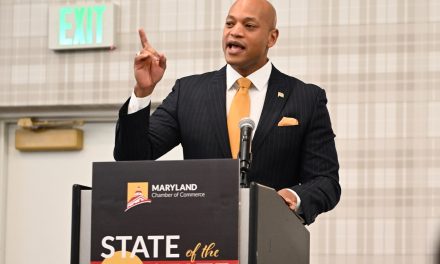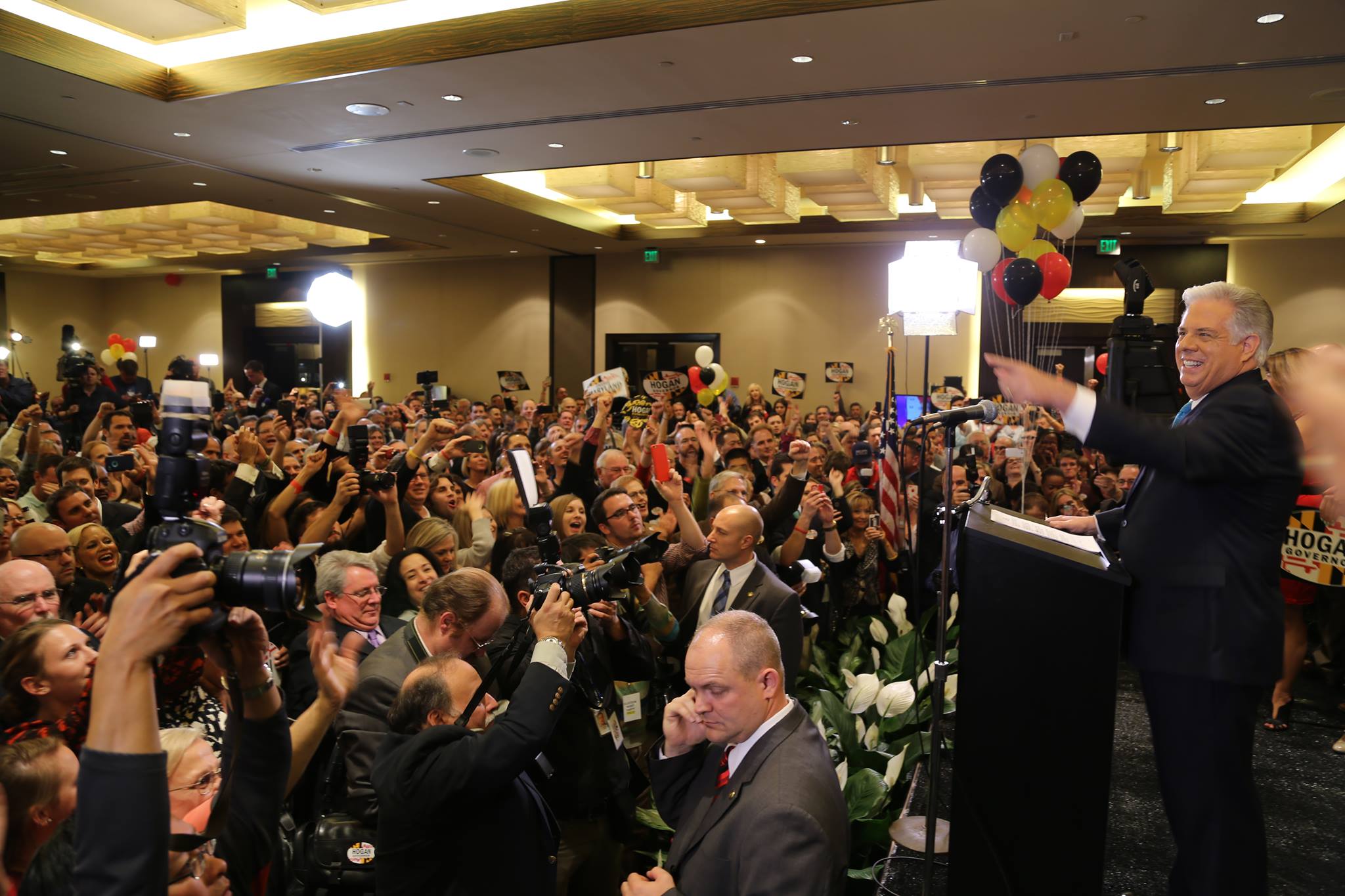Three professors and a columnist — Roy Meyer, Melissa Deckman, Richard Vatz and Blair Lee — analyze the election, assessing who won and who lost, the good, the bad and the ugly. Plus interactive maps illustrate the differences in turnout.
Maryland’s citizens were the biggest losers
By Roy T. Meyers
The conventional wisdom is that Lt. Governor Anthony Brown and the Democrats lost this election, big-time. Of course that’s correct. But the biggest losers in this election were Maryland’s citizens–for this election was largely vacant of information that could help them decide the path that Maryland should take for the next four years.
Much of the fault lies with the two major parties. The Democrats did release a 145-page “Brown-Ulman Plan: A Better Maryland for More Marylanders.” (I’ll gladly send my hard copy to the first reader who asks for it.)
It was full of detailed proposals, consistent with the policy leadership and implementation skill of the O’Malley administration.
Gov. O’Malley deserves much praise for his performance over two terms (with the notable exception of the health exchange disaster), but he was less successful in getting Marylanders to understand the progress that was made under his watch.
Brown’s campaign made this problem much worse. It used simplistic mailers to encourage fear of Mr. Hogan on social issues such as gun control. And Brown wasn’t alone–it was seemingly the only option in the playbook of Democratic campaign consultants in Maryland and across the country.
Pocketbook issues were most important
What a huge mistake. As Hogan properly realized, pocketbook issues were more important to most voters. Why would Maryland Democrats, who historically featured economic fairness in their platforms, not stay on that course? Because they worried about their vulnerability on tax increases that were necessary to survive a Great Recession, which was largely caused by the forces that support their partisan opponents. But repeatedly promising “no new taxes” in this campaign was insufficient protection from the narrative Republicans, and Hogan in particular, have been building over recent years.
Much of that narrative was false or misleading, yet many voters bought it. Though Maryland is still one of the richest and most productive states in the nation, the Republicans convinced many that the economy was worse than most other states’.
Though even after the tax increases of recent years, when Maryland still has below-average tax rates per individual incomes, many voters came to believe that the tax burden promoted flight of high-income taxpayers (there’s no convincing proof of this).
And they credited Hogan’s promise to cut much spending that was wasteful–though analyses of his vague approach clearly showed that it lacked credibility.
Gov. Hogan will have the budgetary power to require lower spending for programs that aren’t driven by statutory formulas and entitlement provisions. He will find, as will voters, that cuts in these discretionary programs often have negative consequences. He will also need to negotiate with General Assembly Democrats to make spending reductions in formula and entitlement programs. But the Hogan campaign said not a word about any specific reductions that they intend to support, and they usually got a free ride on that. More generally, detailed examinations of the many questionable claims by the competing candidates were far less available than typical media “horse race” analyses. That’s understandable to some extent given how the media’s challenging economics has reduced the size of the statehouse press corps.
When fewer citizens pay for coverage, on average they are less well informed.
So in 2015, when the governor and the General Assembly start to wrestle with very complicated issues, let’s hope that they can deliberate over alternative options, carefully considering the details, and then compromise like adults–rather than emulate how most politicians in Washington behave.
But I doubt that this election gave our state leaders any guidance about which policies they should adopt.
Roy Meyers is professor of political science at the University of Maryland Baltimore County. meyers@umbc.edu
A good campaign, a bad one and low voter turnout
By Melissa Deckman
The 2014 Maryland gubernatorial election results can be summed up in three very short sentences:
Larry Hogan’s campaign was good.
Anthony Brown’s campaign was bad.
Voter turnout was low.
Let me elaborate.
Larry Hogan ran a highly disciplined, focused campaigned that defined the terms of the election by hammering Maryland voters about the economy and Maryland’s iffy business climate.
Hogan was also successful in repeatedly linking Brown with the unpopular incumbent Martin O’Malley.
Moreover, the Hogan campaign worked hard, taking its message to all corners of the state and not taking any voters for granted, including those voters in Baltimore City and Prince George’s County, which are Democratic strongholds. Hogan also didn’t take Brown’s attacks lying down, effectively downplaying Brown’s claims that Hogan was extremely conservative on social issues.
Hogan’s ad that featured his daughter Jaymi about reproductive rights was the most effective ad of the campaign season.
By contrast, Anthony Brown’s campaign had the sense of a coronation rather than a political battle. Brown attempted to define Hogan as a right-wing conservative who wanted to repeal abortion rights and gun control, but by doing so, let Hogan define himself as the candidate who cared most about fixing Maryland’s lackluster economy–the issue that voters continue to care most about. Moreover, it soon became clear that Hogan really did not intend to do either of those things.
Most damaging, however, was that Anthony Brown never gave Maryland voters a compelling reason for them to cast their ballots for him. Although his website had ample policy positions, his campaign failed to painted a broader vision of what he wanted for the state.
Last but not least, low voter turnout helped Larry Hogan tremendously. The turnout in the three Democratic strongholds–Baltimore City, Prince George’s County, and Montgomery County–did not pass 39 percent, which hurt Brown’s efforts tremendously. Moreover, the types of voters who turnout in mid-term elections as compared with presidential elections are more likely to lean Republican as the mid-term electorate is more likely to be white, married, older, and male.
According to national exit polls, this is precisely what the electorate looked like in 2014–another factor that greatly helped Larry Hogan win in unprecedented fashion.
Melissa Deckman chair of political science and Louis L. Goldstein Professor of Public Affairs at Washington College in Chestertown.
Two interactive charts tell the story of why Anthony Brown lost
By Karen Mawdsley, Beena Raghavendran, Teddy Amenabar and Morgan Fecto
Capital News Service
Why did Democratic Lt. Gov. Anthony Brown lose the Maryland governor’s race to Republican Larry Hogan on Tuesday in a stunning upset?
One big reason: Hogan had a very strong showing in traditionally Republican-leaning counties, significantly outperforming Republican Bob Ehrlich’s vote totals in his failed campaign against Gov. Martin O’Malley in 2010.
Another big reason: huge numbers of voters in traditionally Democratic strongholds like Prince George’s County, Montgomery County and Baltimore City stayed home. Four years ago, those voters showed up to re-elect O’Malley.
These two charts tell the story.
Hogan was a brick to throw at the State House
By Blair Lee
For months we were told that November 4th would be an historic election in Maryland; the state’s first African American governor and the first to defy the Lt. Governor jinx. Neither happened.
Instead, history was made as, for the first time in Maryland history, a private citizen who never held elected office successfully led a taxpayer’s rebellion that put him in the governor’s mansion and, historically, did it using public funds.
Larry Hogan’s campaign against taxes, spending and the stagnant economy struck a nerve and dovetailed, perfectly, with the national mood of dissatisfaction. Instead of hindering him, Hogan’s non-politician status made him more appealing to voters as a kindred spirit willing to serve as the brick voters wanted to throw at the State House.
Actually, Larry Hogan, the scion of a political family, laid the groundwork for his campaign years earlier by founding “Change Maryland,” an anti-tax, pro business think tank, as his political theme and platform.
His disciplined, single message, low-budget campaign and his gift for salesmanship connected with voters who felt the state and nation were “heading in the wrong direction”. He won by inspiring his supporters to vote and by persuading his opponent’s supporters to stay home.
Depending on turnout
Saying that an election depends on turnout is like saying a football game depends on touchdowns. But voter turnout tells the story of Hogan’s win. Four years ago, when Martin O’Malley defeated Bob Ehrlich, voter turnout (the early vote and election day vote) was 50.4%. Voter turnout this year was 44.5%.
An additional 233,378 voters enrolled between the two elections, yet 102,662 LESS voters turned up this year than in 2010. And most of the voters who did turn up had blood in their eyes.
The result was astronomical Hogan margins (70% to 80%) in the red counties, unusual support in the blues (37% in Montgomery, 22% in Baltimore City) and victory in Howard County where Anthony Brown’s running mate, Ken Ulman, served eight years as county executive.
The low turnout skewed the results such that, in 2010, O’Malley ran better in predominantly African American Baltimore City, PG and Charles counties, than Brown did in 2014.
Concession speech better than campaign
I thought Brown’s concession speech Tuesday night was classy. Why didn’t he campaign like this? Why did he let his handlers keep him locked up? Because once you accept second fiddle, the lieutenant governorship, you stop being an alpha male.
In fact, Brown won all his elections (House of Delegates, lieutenant governor) by being on someone else’s ticket. So, when it came time to run his own campaign, he listened to “the pros” who advised a “rose garden” and attack ad strategy. After all, attacks worked against Ehrlich in 2010 and against Gansler in this year’s primary, surely they’d sink Hogan.
In fairness, Brown never had a chance against Hogan because Brown was chained to the O’Malley administration’s record. Every time Brown tried presenting a vision (pre-K, better business climate) Hogan asked, “You’ve been in charge for 8 years, why didn’t you do it then? ” Likewise, Brown’s “no new taxes” pledge fell sort when Hogan pointed to the massive hikes during Brown’s tenure.
Also, O’Malley’s presidential bid helped sink Brown because Marylanders felt O’Malley was putting ambition above duty. Every headline about O’Malley off to Iowa or New Hampshire cost Brown votes. Lieutenant governors pay for their governor’s sins, that’s why no Maryland Lt. Gov. has ever ascended to higher office. That’s still the case.
Finally, Maryland Republicans can celebrate a Republican victory in the 2nd Congressional District. No, not Maryland’s, West Virginia’s 2nd district where former Maryland state senator and party chair Alex Mooney, gerrymandered out of office in Maryland, moved and which he’ll now represent in Congress. Another Marylander who’s glad he fled the free state.
Blair Lee IV is a weekly columnist for the Gazette newspapers, a commentator on WBAL radio and chairman of the Lee Development Group in Silver Spring.
Brickbats and bouquets for Maryland’s gubernatorial election
By Richard E. Vatz
I have followed the 2014 gubernatorial election in Maryland with a pretty close eye, and I recall no election that had so many responsible and irresponsible components.
Therefore, here are my awards of Bouquets and Brickbats for the most strikingly ethical/unethical and effective/ineffective persuasive efforts of the campaign for Governor. You may add your own, but, fortunately or unfortunately, not in this article. [Comments are permitted at the bottom]
Bouquets:
- To Del. Heather Mizeur for unambiguously opposing gerrymandering, the undemocratic Democratic strategy for rewarding political friends and punishing political enemies. Guess it didn’t work to punish Jim Brochin; he was too good a candidate.
- Speaking of Jim Brochin: To Sen. Brochin for his most brilliant ad, courtesy of Dr. Seuss (Theodor Seuss Geisel), a parody of “Green Eggs and Ham” in which he tastefully and without mentioning his opponent depicted himself as an independent who stands against his own party’s governor’s serial taxing practices. I personally, if not politically, like the current governor, but this ad was delicious.
- To Larry Hogan for abjuring negative ads after his first one very early in his campaign which called Lt. Gov. Anthony Brown, “The Most Incompetent Man in Maryland.”
- To the Maryland electorate, who were unpersuaded by visiting political star endorsers and in effect, in Walter Mondale’s phrase, demanded to know of Mr. Brown, Where’s the beef?”
Brickbats:
- To Del. Mizeur, who made no distinction between personal and irrelevant negative campaigning on one hand, and legitimate issue-centered negative campaigning on the other. In criticizing Attorney General Doug Gansler’s attempts to question Anthony Brown about his tax-and-spending policies during the Democratic primary debate, Ms. Mizeur’s irritation at such “negativity” made any inroads impossible. A person very close to the Gansler campaign tells me he (Gansler) was furious. I saw no such fury publicly. After communicating her dissatisfaction to the Brown campaign for his tasteless and false campaigning, she was given a version of “We’re going in a different direction” (i.e., “go pound sand”), and she showed that she would not take such insolence and endorsed Mr. Brown, saying she “still embrace[s] the man that is Anthony Brown.”
- To Lt. Gov. Anthony Brown for his classic malicious negative campaigning, replete with falsehoods, irrelevancies and tasteless attacks (the “FIT Test” of negative campaigning), including: 1) Claiming Mr. Hogan opposed abortion in cases of incest and rape, and 2) Claiming Mr. Hogan was “a dangerous man” and “radical” and, added a Democratic Party flier, one who was implicitly racist and sexist. Complementing this campaigning was Mr. Brown’s consistent refusal to substantively address the issues of his responsibility for the healthcare mess and the taxing and the spending policies of the administration of which he was a major member.
Congratulations to the Maryland electorate for their seeing through the obfuscatory strategies in this campaign, and I should like to award one final brickbat, #3 to the author of this piece who predicted that they would not do so.
Professor Richard Vatz teaches political rhetoric at Towson University and is author of The Only Authentic Book of Persuasion: the Agenda/Spin Model (Kendall Hunt, 2013)







The only hope for smart businesses and residents is to leave this Democrat sinkhole. These Democrat uninformed sheeple voters have helped ruin Maryland. Myself and many others are planning on leaving this state. I rather live in a fiscal responsible state. Maryland is not that state.
A little too much credit is going to Hogan’s ground game. ANYONE was going to beat Brown as long as they didn’t commit a violent felony before Nov. 4.
Brown seemed entirely out of place to be governor. He demonstrated no maturity, no savvy and no patience with reasonable questions from the press. In many instances Brown acted like a spoiled little brat.
And Hogan is not that charismatic, unless of course he’s standing next to Brown.
If this was such a Republican wave it sure didn’t reveal itself in the AG campaign because GOP challenger Jeffrey Pritzker got walloped by Sen. Brian Frosh, who won by a 3-2 margin.
And Marylanders voted for Comptroller Peter Franchot along the same margins that O’Malley won by in 2010, also a 3-2 margin.
Hogan won because Brown was a complete train wreck.
Maryland’s 2014 election will go down as rebuke of one guy, so lets temper the giddy prognostications from the right with a smidgeon of reality. The GOP will never be allowed to change policy in the Democratic stronghold of Maryland.
Now lets sit back and watch Senate President Mike Miller tool Hogan for the next four years.
Four thoughtful opinions on the Hogan-Brown election outcome. Just hope that the leadership of the Democratic party will realize that taxes are not the only option and that the Hogan Administration will focus on the economy and the creation of more middle class jobs.
I think Roy is implying Maryland voters were duped by the republican message.
The fact is, the national economy is growing, but that growth does not include wage growth, which has been negative, or hiring, two very important issues bot nationally and and locally. What voters did come to believe that despite tax increases, the governor and legislature passed budgets that exceeded realistic revenue estimates which lead to mid fiscal year collapses. Another thing that sits heavily on public and school employees is the pension fund. The governor withheld hundreds of million in state payments. At some point in the future, the retirees will suffer for this and the state legislature will have the terrible task of taking away promised benefits because of O’Malley.